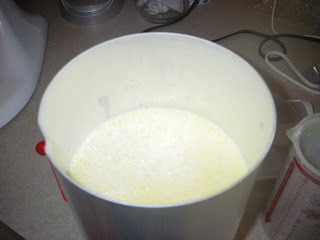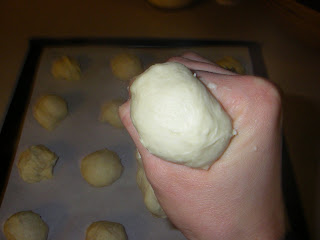 Mennonite Monday started because I wanted to make recipes from the Bethesda Mennonite Church Cookbooks (both the yellow and the white cookbook for those of you who own them). I also wanted to take pictures of each recipe that I made, so I would know for future reference what the recipe should look like. I am by no means a great cook, but I think it will be fun to try new and different recipes each week. Not all of these recipes are for ethnic Mennonite food, but the women from Henderson know how to cook, so I can safely say that these recipes will be good. Check back each Monday for a new recipe and feel free to leave a comment if you have a favorite recipe from these cookbooks, or if you have some tips on what I should make and how I should make it.
Mennonite Monday started because I wanted to make recipes from the Bethesda Mennonite Church Cookbooks (both the yellow and the white cookbook for those of you who own them). I also wanted to take pictures of each recipe that I made, so I would know for future reference what the recipe should look like. I am by no means a great cook, but I think it will be fun to try new and different recipes each week. Not all of these recipes are for ethnic Mennonite food, but the women from Henderson know how to cook, so I can safely say that these recipes will be good. Check back each Monday for a new recipe and feel free to leave a comment if you have a favorite recipe from these cookbooks, or if you have some tips on what I should make and how I should make it. ~
This week Mike encouraged me to tackle my first attempt at Zwieback, the first item on my
bucket list. Luckily I didn't have a full schedule on Saturday, so I was able to take on the challenge and I'm pleasantly surprised with how well it went for my first attempt.
For those that don't know, Zwieback, also known as Two Bakes, is a Mennonite bread. It is different from regular dinner rolls because it is a sweater bread and it has a certain smell and taste if you make them right.
I referenced three different cookbooks while making the Zwieback. I referenced the white church cookbook and the red Henderson Homemakers Club Cookbook, but ultimately used a recipe from the yellow cookbook on page 9.
Zwieback
2 cups margarine (melted)
4 cups milked (warmed)
2 cups water
5 pkgs or 10 teaspoons dry yeast
1/2 cup sugar
2 tablespoons salt
about 16 cups flour
Combine margarine, milk, water, salt, sugar and yeast, then slowly add flour, about 3 cups at a time. Stir until smooth after each addition, until stiff enough to knead by hand. Let rise until double in bulk. Then form into walnut size balls and place one on top of another on a cookie sheet. Let rise until double in size and bake in a 400 degree oven for 15 to 20 minutes.
(1 recipe suggests using 1/2 cup oleo and 1 cup lard and crisco mixed in place of the 2 cups margarine.)

The white stuff in the tub is lard. I had lard from butchering in February, so I was pretty excited to use it, but I had a little miss understanding in my substitution for the margarine. For some reason I though oleo was crisco. For those of you that know what oleo is, you are probably laughing and for those of you that don't, let me tell you that oleo is margarine. With that said, using 1/2 cup lard and 1 1/2 cups crisco, worked fine. I am going to do it the right way next time, so it will be interesting to see how different the Zwieback turn out.
I mixed all of the crisco and lard first with a little milk, while the yeast was in the warm water activating.
The mixture of the lard and crisco looked creamy and at this point I added all of the other ingredients except the flour.
Once these ingredients were added the crisco became a little lumpy again, but I figured it would smooth out as I added the flour.
After the first three cups of flour.
Second set of 3 cups of flour
Third set of 3 cups of flour
Fourth set of 2 cups of flour. At this point I put on the dough mixing hook and the shield because the mixer was very full.
Final 2 cups of flour. You can see that the dough completely filled the mixer.
This is how much dough there was before it started to rise.
Since we haven't had sunshine in a long time, I had to set the dough in front of a heater by the window in our living room to get the dough to rise.
After the dough has risen for about an hour.
To make the Zwieback, you take a hand full of dough.
And squeeze it between you fingers, so it makes a ball shape that you can pinch off. You put each of these balls onto the pan and then put another ball on top. I tried to push down the first ball a little so the second ball would set on top better.
I have never done this before, so there was a learning curve here, but I remembered once when I was at my Great Grandma Anna's, when I was young, she did it this way. When my mom and dad got married, they received fresh baked zwieback each week from by grandma and great grandma, so there was never a reason for my mom to make zwieback and show me how. It does make me laugh that I remember how my great grandma squeezed off balls of dough for zwieback because she was not known for her efforts in the kitchen. We would sooner see her working on the farm, but that's a whole other story.
A pan full of zwieback before they rose.
After they rose for almost another hour. I made a little dent in the top of the zwieback with my finger. I'm not sure why we do that, but that is what is done.
It is amazing how good the house smells when these are baking. The smell reminded me of my grandmas house, so I knew I was on the right track.
Not all of my zwieback turned out perfectly, but they did taste good. On the picture above, the left is not how zwiebuck is suppose to look and the right is how it should look.
From the side view. The left is bad and the right is good.
Some background information on Zwieback
There are several ways to say Zwieback. I pronounce it as Tway-buck. Some people say Zwee-bock. It was very common for women to make Zwieback every week, so they had it on hand for breakfast and other meals. One such meal is Faspa. According to the Homemaker's Club Cookbook:
Faspa (Lunch)
"Faspa" is a lunch served in the afternoon around 3:30 p.m. or later. "Faspa" is almost a must on Sunday afternoons. It is taken for granted that when you go visiting on Sunday afternoon, invited or not, that you will be served "faspa" by your hostess. Almost everyone is prepared to serve such a lunch, too.
The main item on the menu, of course, is zwieback, though at times bread is substituted. Jelly, coffee, cheese, lumps of sugar, cake, cookies or other sweets complete the meal.
Sometimes a large group of individuals happen to visit at the same place on the same Sunday afternoon. This can put the hostess into quite some anxiety, wondering if her food supply will be adequate. Perhaps she can slip out the back door and borrow a few zwieback from the neighbors. If that isn't possible, crackers often have to suffice.
Since this cookbook was published in 1951, a lot has changed. I would guess that faspa isn't as common as it use to be, and if you were to have unexpected guests, you neighbor would probably not have spare zwieback, if you were to slip out the back door. However, part of me thinks it would nice if we still took time slow enough to enjoy faspa on a Sunday afternoon with friend and family, but I can't say that my house is kept clean enough for unexpected guests like that either.
















































